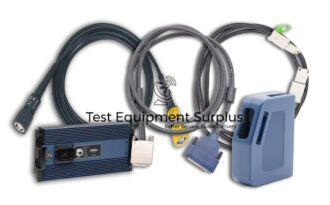Description
The National Instruments SCXI-1000 Chassis is identified by multiple part numbers, including 776570-01 through 776570-10 and 778570-01 and 778570-04, and is designed to house up to eight SCXI-1000 chassis units. This chassis provides seven power options to meet various international electrical standards and supports line voltages of 100, 120, 220, and 240 VAC, with voltage configuration managed by a tumbler in the power entry module.
It operates in either multiplexed or parallel modes, offering flexibility in signal routing and module communication. The SCXI-1000 can be configured for one of 32 addresses using the switches on the front panel that correspond to values of 1, 2, 4, 8, and 16. With physical dimensions of 9.8 x 7.7 x 7.0 inches and a light weight of 10 oz, it is a compact solution for a variety of applications.
The chassis efficiently dissipates 7 W per slot and is designed to operate within a temperature range of 0 to 50 °C, ensuring reliable performance in diverse working environments.
| Specification | Detail |
|---|---|
| Part Numbers | 776570-01, 776570-02, 776570-03, 776570-04, 776570-05, 776570-06, 776570-07, 778570-01, 778570-04, 776570-09, 776570-10 |
| Product Type | National Instruments SCXI-1000 Chassis |
| Chassis Slots | Accommodates up to 8 SCXI-1000 chassis |
| Power Options | Seven different power options to comply with international electricity standards |
| Line Voltages | 100, 120, 220, 240 VAC |
| Voltage Configuration | Voltage tumbler in the power entry module |
| Operating Modes | Multiplexed mode, Parallel mode |
| Address Configuration | 32 different addresses via front panel switches (values 1, 2, 4, 8, and 16) |
| Physical Dimensions | 9.8 x 7.7 x 7.0 inches |
| Weight | 10 oz |
| Power Dissipation | 7 W per slot |
| Operating Temperature Range | 0 to 50 °C |
Question 1: What are the part numbers for the National Instruments SCXI-1000 Chassis, and what are its operating modes, power, and address configuration options?
Answer 1: The National Instruments SCXI-1000 Chassis has physical dimensions of 9.8 x 7.7 x 7.0 inches and a weight of 10 oz, and it efficiently dissipates 7 W per slot.
Question 2: Could you detail the voltage configuration and chassis addressing capabilities of the National Instruments SCXI-1000 Chassis, along with its physical traits and operating temperature range?
Answer 2: The National Instruments SCXI-1000 Chassis offers seven power options to cater to different international electrical standards and supports line voltages of 100, 120, 220, and 240 VAC; it is capable of operating in both multiplexed and parallel signal routing modes and can be configured for one of 32 addresses using front panel switches with values of 1, 2, 4, 8, and 16.
Question 3: What are the various power options and voltage supports available for the National Instruments SCXI-1000 Chassis, and what are its capabilities in terms of signal routing modes and configuration addresses?
Answer 3: The National Instruments SCXI-1000 Chassis supports line voltages of 100, 120, 220, and 240 VAC with a voltage configuration managed by a tumbler in the power entry module; it can be configured for one of 32 addresses using the front panel switches that correspond to values of 1, 2, 4, 8, and 16. Physically, the chassis measures 9.8 x 7.7 x 7.
Question 4: What are the physical dimensions and weight of the National Instruments SCXI-1000 Chassis, and how much power does it dissipate per slot?
Answer 4: The part numbers for the National Instruments SCXI-1000 Chassis range from 776570-01 to 776570-10 and from 778570-01 to 778570-04; it operates in either multiplexed or parallel modes, supports line voltages of 100, 120, 220, and 240 VAC, and can be configured for one of 32 addresses using front panel switches with values of 1, 2, 4, 8
Question 5: What are the power options and line voltage support provided by the National Instruments SCXI-1000 Chassis, and how is voltage configuration managed?
Answer 5: The National Instruments SCXI-1000 Chassis provides seven power options to accommodate various international electrical standards and supports line voltages of 100, 120, 220, and 240 VAC, with voltage configuration managed by adjusting a tumbler in the power entry module.



